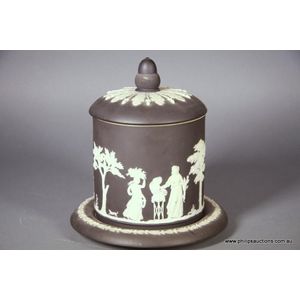Wedgwood Black Jasperware Biscuit Barrel, 1889
You must be a subscriber, and be logged in to view price and dealer details.
Subscribe Now to view actual auction price for this item
When you subscribe, you have the option of setting the currency in which to display prices to $Au, $US, $NZ or Stg.
- Slipware Pottery - When people think of how pottery is made, they usually imagine clay being thrown on a wheel. This is still a common method used by studio potters, together with coiling and carving. However, these techniques are time-consuming and so for factory production, a quicker and cheaper method is essential. Such a method is slip casting.
In slip casting, a clay slurry is poured into a plaster of Paris mould. When the clay has dried, the mould is taken apart and the pot allowed to dry further. It may then be fired, decorated and glazed.
Most factory produced mid 20th century pottery was slipware. Huge quantities were maufactured for the 'popular ornaments' market. - Circa - A Latin term meaning 'about', often used in the antique trade to give an approximate date for the piece, usually considered to be five years on either side of the circa year. Thus, circa 1900 means the piece was made about 1900, probably between 1895 and 1905. The expression is sometimes abbreviated to c.1900.
- Frieze - An architectural term denoting the flat, shaped or convex horizontal surface of furniture, between the architrave and the cornice, usually found on a cabinet or bookcase, or on desks and tables where it may include drawers, the area between the top and the legs. In ceramics, the term refers to the banding, of usually a repeating pattern, on the rims of plates and vases.
- Finial - An architectural decoration, found on the upper parts of of an object. On furniture they are usually found on pediments, canopies and shelf supports. On smaller ceramic or silver items, such as spoons, they may decorate the top of the item itself, or the lid or cover where they provide a useful handle for removal.
Finials have a variety of shapes and forms. They may be urn-shaped, baluster shaped round or spiral, but usually taper into an upper point. Many real life shapes may also be used as finials, such as pineapples, berries, pinecones, buds, lotus and acorns. Sometimes animals such as a lion are depicted, or fish and dolphins.
This item has been included into following indexes:
Visually similar items

French Longwy pot with enamelled decoration, and plated lid, approx 12 cm high

A large antique blue Jasperware cheese dome and base 19th century, unmarked. In deep ultramarine with an acorn finial surrounded with anthemion motifs, decorated in white slip decoration to the cover with classical figures and continuous borders of morning

George iii sterling silver tea caddy with an ebony finial marked London, 1790, WS 220g

Chinese glass snuff bottle jade stopper painted birds butterflies flowers 9 cm high
